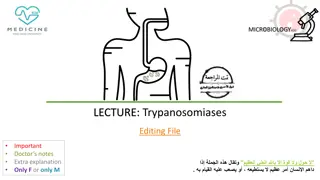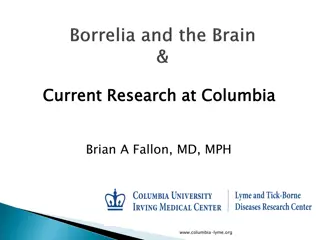Understanding the Complexities of Lyme Disease
Lyme disease, caused by the spirochete Borrelia burgdorferi, presents unique challenges due to the bacteria's ability to evade the immune system, slow reproduction rate, and lack of classic bacterial weaponry. Unlike other bacterial diseases, Lyme may not always exhibit clear symptoms, has varying timelines, and diagnostic tests are only 50% accurate. Antibiotics are not always effective as Borrelia are antibiotic-tolerant. The complex relationship between Borrelia and hosts, involving animals and ticks, adds to the medical challenge of Lyme disease.
Download Presentation

Please find below an Image/Link to download the presentation.
The content on the website is provided AS IS for your information and personal use only. It may not be sold, licensed, or shared on other websites without obtaining consent from the author. Download presentation by click this link. If you encounter any issues during the download, it is possible that the publisher has removed the file from their server.
E N D
Presentation Transcript
What makes Lyme disease such a medical challenge? Holly Ahern MS, MT(ASCP) Associate Professor of Microbiology SUNY Adirondack, Queensbury, NY ahernh@sunyacc.edu
Lyme Disease A Tick-borne Spirochetosis? Lyme disease in humans was first described in 1977 as an epidemic of arthritis preceded by a rash. Dr. Wilhelm Burgdorfer dissected ticks from Shelter Island NY and found them to be full of microbes. Burgdorfer showed that one of them, a spirochete in the genus Borrelia, caused the same type of disease when rabbits were infected. The spirochete was named Borrelia burgdorferi, and this sole bacterium is STILL considered the one and only cause of Lyme disease in the United States.
Borrelia are not like other bacteria Other Bacteria May survive outside a host Reproduce rapidly and grow to large numbers Have an arsenal of sophisticated weaponry Engage the host immune system Induce strong and long- lasting immunity. Borrelia Can t survive without a host Reproduce slowly and sometimes don t reproduce at all. Lack classic bacterial weaponry like toxins or enzymes. Evade or subvert the host immune system Seldom induce strong or long lasting immunity
Lyme disease is not like other diseases caused by bacteria Other Bacterial Diseases Disease is apparent with a defined beginning and end Clear and characteristic signs and symptoms Accurate diagnostic tests are available Antibiotics are a very effective treatment because the bacteria are reproducing Lyme disease Disease may not always be apparent and timeline varies Multi-system disease that isn t always the same Diagnostic test endorsed by the CDC is only 50% accurate Antibiotics are not always effective because Borrelia are antibiotic tolerant bacteria
Relationships between Borrelia and hosts are complicated They have a life cycle that involves animals and ticks. Exceptional, well adapted animal commensals that cause persistent BUT NOT DISEASE INDUCING infection in their reservoir host (mice in our area). Partner with blood sucking insects (ticks) to get transmitted to new host animals (including us). Long-lived animals (like us) with strong adaptive immunity experience symptoms of disease but no sterilizing immunity Disease symptoms are due largely to infection- associated inflammation
Borrelia live a complicated life A Genome is more complex than any other bacteria One chromosome, multiple plasmids. Vary gene expression depending on environment B Exchange genes with other Borrelia Genetic variation leads to ongoing evolution of new genospecies of Borrelia which ones actually cause Lyme disease? Cells change over time ( pleomorphic ) A. Spirochete (twisted rod) is motile and swims B. Non-motile forms produce a BIOFILM C. Twisted form balls up into a rounded form which stop eating and reproducing, become antibiotic tolerant persisters C
Our immune system responds to the same Borrelia in different ways Spirochetes forming round bodies Borrelia spirochetes Biofilm of Borrelia Round body persisters
Why blood tests for Lyme disease dont work Current gold standard blood tests detect immune system response to infection, NOT the infection itself. Bacteria shut down antibody production by disrupting germinal centers in lymph nodes. Borrelia changes its surface antigens to trick the immune system. Other Borrelia species cause Lyme disease or Lyme-like disease. Blood tests are specific for ONLY the SPIROCHETE FORM of B. burgdorferi Accuracy of this test is <50%
Why a standard antibiotic treatment approach doesn t always work Antibiotic dose required to kill bacteria in biofilm for is 1,000 5,000 times higher than for motile forms. Pleomorphic forms (called cysts or round bodies or persisters) are antibiotic tolerant They slow their rate of growth They become dormant persisters with no reproduction Remove antibiotic challenge, growth rate speeds up and/or persisters reactivate causing recurrence of symptoms
So, what does work? Thanks to funding from non-profit organizations, research to identify antimicrobial agents effective against Borrelia spirochetes and persisters is finally underway Congress NIH and CDC are federal agencies funded by tax dollars. Why isn t more being done???
What we NEED: An accurate diagnostic test for all known tick-borne diseases Better rate of accuracy (>50%) Detects actual presence of bacteria Based on genomic analysis detects DNA or RNA from more than just Borrelia burgdorferi Better treatment approaches, for tick bite AND BEYOND Identify new antimicrobial drugs that work against Borrelia persisters Identify new approaches that work against bacterial biofilms Investigate how Borrelia infection evades and disables the immune system STOP MARGINALIZING PATIENTS WHO DON T RECOVER AFTER 2 WEEKS OF ANTIBIOTICS Ways to prevent tick bites in the first place! Oral vaccine in pellets for mice Chemical and biological treatments; environment and personal protection LEADERSHIP from US and State reps Public Health Policies for Lyme disease MUST BE CHANGED!























